Japanese cars
New Cars to Buy – Exciting!
Along with the new SUVs showcased last time, Australia will also see some other exciting vehicles arriving in the coming months. Keep your eyes out for the following:
Honda
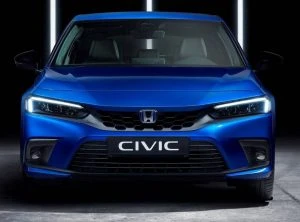
Civic Hybrid
Honda’s new Civic hybrid has its own subtle design features that set it apart from other Civic models. Hybrid-specific displays for the infotainment screen and instrument cluster gives the car its own environmentally friendly twist, plus the revised rear bumper is designed to conceal the exhaust outlets. Honda’s Civic Hybrid also gets blue accents for its Honda badges, and there is a special e:HEV tailgate badging to set it off nicely.
As a driver, the new Honda Civic Hybrid is an impressively competent vehicle with great economy and plenty of get up and go. The Civic HEV’s hybrid system is based around the 2.0-litre naturally-aspirated Atkinson-cycle petrol motor that is found in the current Honda Accord VTi-LX Hybrid. Matching the engine output to a smooth CVT automatic makes for an excellent easy car to drive. 315 Nm of torque provides grunt when you need it and the 135 kW of peak power suits this car well and delivers a bigger punch than the standard Civic’s 131 kW/240 Nm levels.
The front-wheel drive Honda Civic Hybrid is likely to be more efficient than the Accord Hybrid and even more so than Toyota’s Corolla Hybrid (4.2 litres/100 km).
BYD
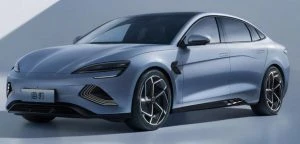
BYD Atto 4
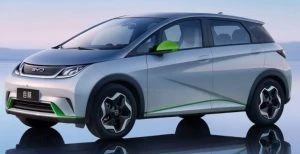
BYD EA 1 (Dolphin)
BYD Auto is the largest EV manufacturer in the world and is the automotive division of the Chinese multinational manufacturer BYD Company. Along with some SUV models, BYD is also bringing their Atto 4 sedan and their neat little EA 1 to Australia.
The BYD Atto 4 is a mid-size sedan that looks beautiful, sporty, and aerodynamic. Equipped with loads of the latest technology and also obtaining power from large batteries with a unique design, the Atto 4 impresses. Standard Atto 4 versions get a 61.4 kWh battery pack and a claimed 550 km range. The pricier models get a larger 82.5 kWh unique Blade battery with a claimed range of up to 700 km. Having the larger battery and an AWD system, this flagship BYD Atto 4 can reach 100km/h from a standstill in just 3.8 seconds!
More BYD excitement has the imminent arrival of the BYD EA 1 Hatchback. In China they call the BYD EA 1 the rather endearing name ‘BYD Dolphin’. This is a small Chinese EV hatchback that is being picked to be priced at or less than $30,000 in Australia. The small all-electric hatchback will be available with various battery and drivetrain configurations, all using a single electric motor to power the front wheels.
Two battery capacities: 30.7 kWh or 44.9 kWh will be available for the EA 1, both of which can be paired with a 70 kW/180 Nm motor. The larger 44.9 kWh battery can also be linked to a 130 kW/290 Nm motor, providing swifter acceleration and cruising speeds. Larger batteries will also become available over time for the little EA1 – particularly necessary, as Australia is a pretty vast land mass.
Managing director, Luke Todd, stated that “Our view is [that] in Australia any EV must have a minimum – even for city running – of 400 km to be accepted in the Australian market. All of our vehicles will have at least a 400 km range … our target is 500 km-plus.”
Cupra
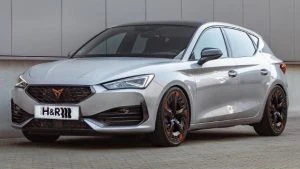
Cupra Leon
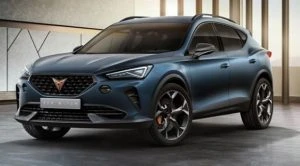
Cupra Formentor
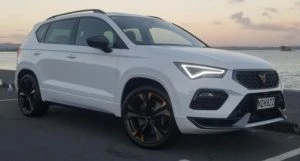
Cupra Ateca
Cupra is a Volkswagen-owned Spanish brand who have opened their doors to import their vehicles to Australia, offering us a 3-strong model range.
The exciting range of Cupra cars – Ateca (SUV), Leon (Hatchback), and Formentor (Crossover) – will spearhead the Australian line-up.
The Cupra Ateca SUV comes exclusively in the VZx form, so 221 kW of power and 400 Nm of torque is sent through the 4Drive AWD system to deliver 0-100 km/h in 4.9-seconds. I can see plenty of performance-SUV lovers who want to drive something as unique looking as the Cupra Ateca SUV wanting one!
The Cupra Leon Hatchback will be offered in VZ, VZe and VZx specification levels. So along with plenty of technology and differing variants, there will be a 2.0-litre turbo 140 kW/320 Nm, 180 kW/370 Nm, 180kW/400 Nm (Hybrid), and 221 kW/ 400Nm outputs respectively. So, there’s something for everyone here!
The Cupra Formentor is the Crossover Cupra and boasts the 4Drive AWD system on the V and VZx variants. Note the gorgeous crossover body styling that brings with it plenty of space, practicality and comfort.
All new Cupras sold in Australia will include a 5-year, unlimited kilometre warranty.
Volvo
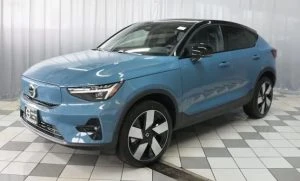
Volvo C40
Volvo has a new C40 coming! There are two versions offered that are based around one having a single electric motor and the other a dual electric motor layout. The Volvo C40 shares the electric powertrains with the XC40. Boot space is measured at 413 litres for both the single and dual motor versions.
Volvo’s the single motor C40 uses a 69 kWh battery pack and a single electric motor over the front axle. It produces 170 kW of power and 330 Nm of torque, combining nicely to provide drivers with a potential 0-100km/h dash being finished in 7.4 seconds. A full charge has a range of over 400 km.
Jump over to the Volvo C40 with its dual motor system, and you’ll find a larger 78 kWh battery pack. An electric motor for the front axle and an electric motor for the rear axle has this Volvo C40 equipped with AWD and capable of seeing off the 0-100km/h sprint in a claimed 4.7 seconds. That’s pretty swift! Again, a full charge should be able to take you over 400 km.
The single motor Volvo C40 kicks off at around $74,990, and the dual motor model around $82,490.
Audi
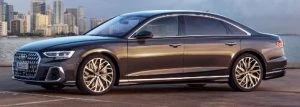
Audi A8
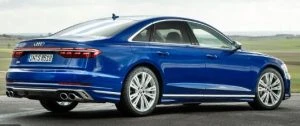
Audi S8
Audi’s A8 and S8 facelifts are coming. The A8 Sedan and Audi’s sportier S8 version have been a stunning proposition for some time, and they keep getting better. Quite an attractive large and luxurious sedan, the 2022 A8 delivers new levels of technology in the areas of comfort, entertainment, and safety.
The stunning A8 exterior remains similar to the outgoing model but you will find some nice subtle changes on the outside. 18–21-inch rims are available with six new designs to choose from. Audi’s ‘singleframe’ grille has been widened and pushed out at the bottom corners for a sportier, more athletic appearance.
The luxury sedan has grown a bit longer, making Audi’s flagship even more comfortable. It competes with the best big sedans from Mercedes Benz, BMW, and Lexus, so the relaxation seat package comes as no surprise, adding a back massage function, a foot warmer, an optional centre control console, and a fold-out table. 23 Bang and Olufsen speakers create an amazing audio sound.
Around the world, the new Audi A8 and A8 L versions will offer a wide selection of chiefly twin-turbo V6 engines that have 48-volt mild-hybrid assistance. All models will boast Quattro AWD and an 8-speed automatic. Audi S8 versions get the sweet-singing twin-turbo 4.0-litre V8 petrol ICE that can move this luxury–sports sedan from 0-100km/h in just 3.8 seconds. Boasting all-wheel steering, the S8 is a nimble thing of beauty.
Citroen
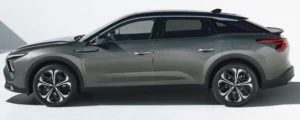
Citroen C5 X
Citroen calls the C5 X a “unique combination of the elegance of a sedan, the dynamism of a wagon and the elevated stance of an SUV”.
In my eyes, the new Citroen C5X looks both elegant and comfortable – just like a special Citroen should. The Citroen C5 X is a large 5-seater that measures 4805 mm in length. Luggage capacity is 485/1580 litres for the PHEV version and 545/1640 litres for the ICE car. Inside its cabin, you’ll find the C5 X is very comfortable, and the sensible interior layout is pleasant on the eye. A load of high-tech interior features include a digital driver’s display, a big 12.0-inch central touchscreen, Android Auto, Apple CarPlay, and a novel toggle gear shifter.
Adaptive dampers increase the Citroen C5 X’s ability out on the road, ensuring that those of us who love comfort can ride all day in a C5 X, all very comfortably indeed.
Equipped with the 165 kW/300 Nm 1.6-litre turbo-petrol four-cylinder ICE, the Australian version will have decent power (0-100 km/h in 8.8 seconds) while being hooked up to an 8-speed automatic transmission and FWD. A top speed of 232 km/h is doable. Citroen’s Australian importer is also considering launching the new Citroen C5 X with a PHEV powertrain. This system mates the 1.6-litre turbo ICE with an 81.2 kW electric motor and a 12.4 kWh lithium-ion battery for a total system output of 165 kW and a claimed electric range of 50 km (WLTP). The PHEV version is slightly quicker, boasting a 7.9 second time for the 0-100 km/h dash.
Peugeot
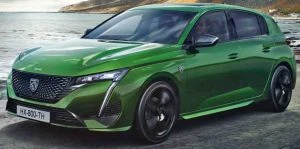
Peugeot 308
Peugeot is bringing us the next-generation 308 and the 3rd generation 308 is a classy looker from any angle you care to look at it from the curb side. Peugeot’s Australian line-up will consist of 4 variants: the 308 GT Hatch, 308 GT Premium Hatch and Wagon, and the Peugeot 308 GT Sport PHEV hatch – a plug-in hybrid (PHEV).
The PHEV versions of the 308 Hatch and Wagon will use larger batteries and more powerful motors than you’ll find in the smaller Peugeot e-208 supermini models. A Peugeot 308 GT Sport PHEV model sees a 132 kW 1.6-litre turbocharged 4-cylinder ICE unit paired to an 81 kW electric motor. The total output of the powertrain sends out a sprightly 165 kW of power and 360 Nm of torque to an AWD system for maximum traction and plenty of excitement.
New 308s with ICEs will be powered by a 1.2-litre turbocharged 3-cylinder petrol engine that produces 96 kW of power and 230 Nm of torque. This little engine is paired with an Aisin-sourced 8-speed automatic transmission that sends the power to the front wheels. Peugeot offers an e-308 in Europe, which is a pure electric variant.
Ford
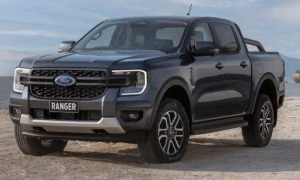
Ford Ranger Ute
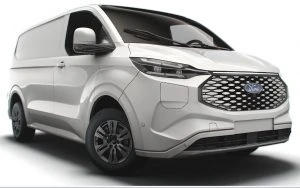
Ford E Transit
The new Ford Ranger Ute is packed with smart functionality and a cool ‘Tonka Toy’ appearance. Commands via voice, phone, or the central touchscreen has you controlling many of the infotainment features. Wireless phone charging, a smart climate control system, and a new digital cluster for the driver keeps the tough new Ford Ranger models at the head of the pack. Its chunkier styling with a wider stance, big towing capacity, and superior off-road ability are part of the new Ford Ranger experience.
Like the brand new Ford Everest SUV, the Ranger Ute houses the latest 3.0-litre turbo diesel V6 ICE, which is also offered alongside the existing 2.0-litre twin-turbo 4-cylinder diesel engine for 2022/23. The V6 boasts 184 kW of power at 3250 rpm and 600 Nm of torque from 1750-2250 rpm.
Ford’s latest E-Transit vans will be available with an all-electric powertrain for more efficient, zero-emissions driving.
Genesis
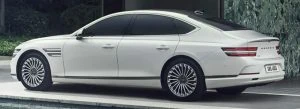
Genesis G80 Sedan
The charming Genesis G80 Sedan has gone pure EV and it is a stunner on the styling front. The car’s opulence and quiet ride will impress. An 87.2 kWh lithium-ion battery pack is housed under the floor, and a claimed Worldwide Harmonised Light Vehicle Test Procedure (WLTP) range of over 500 km is a decent amount of travel. The G80 EV Sedan has a pair of electric motors that work in unison to develop a maximum of 272 kW. This level of power combines with instantaneous torque of up to 700 Nm. These are powerful figures, allowing the luxurious Genesis Sedan to sprint from 0-100 km/h in less than 5 seconds.
How will Australia manage the EV transition as the UK and Japan make their move?
Japan recently joined the growing ranks of countries that are set to move towards a ban on petrol and diesel-powered new cars, emphasising the need to shift towards a new generation of fuel technology.
With the framework for a transition by the middle of the next decade looking set to be a priority for the Japanese government, it is clear that Japan is ramping up its efforts to achieve a goal of being net carbon neutral by 2050. This means the sale of new cars with internal combustion engines could be at an end by the mid-2030s.
As mentioned above, Japan is merely one of a number of countries making the switch.
European lawmakers have been on the frontline in terms of making changes. And those changes are only coming up quicker, as countries accelerate efforts to meet net zero goals. In the UK, the sales ban on new petrol and diesel-powered cars is now targeting 2030 as opposed to the original timeline of 2035.

How might this impact new cars in Australia?
By now, and after a federal election where a green mandate has been given, you’re probably either chastising our politicians for not following suit, or alternatively, you might be wondering what does this all have to do with Australia?
The ramifications for motorists down under are more complex than you might believe. The UK and Japan are the largest markets in the world for right-hand-drive vehicles. Even Singapore, another right-hand-drive market, has pencilled in a 2040 deadline for the transition away from the internal combustion engine.
While the local government has yet to make any significant inroads as far as incentivising drivers to take up cars powered by electric or hybrid means – in fact, some state governments have introduced road user charges that are hardly helping the cause – this absence is quite stark when compared to overseas markets where motorists have a number of incentives and the infrastructure in place to consider buying a vehicle powered by ‘green’ energy. And of course, EV prices are far more affordable overseas. Uptake is picking up quickly in a number of international markets, with the building blocks in place to encourage drivers to make the switch, and pioneers like Tesla changing the game.
With Australia no longer in the picture as a car manufacturer, nor is it ever likely to be one in the future given the prohibitive costs associated with the industry down under, the prospect of the world leaving Australia behind shouldn’t be ignored.
Not only could Australia be left behind as other countries transition to more efficient and technologically sophisticated vehicles, but the cost of supplying Australia with right-hand-drive vehicles could increase as economies of scale begin to dissipate if not evaporate for car manufacturers. If this happens, you better believe that those companies will be passing on the costs to local motorists in the form of higher prices – as if manufacturers haven’t been increasing prices a number of times over the last couple years already.
Solid-State Batteries for EVs

The flourish of new electric vehicles (EVs) and hybrids on the auto markets hint towards the diminishing of fossil fuel use. EV sales have a long, long way to go before outselling vehicles with internal combustion engines (ICEs), but the goals have been set by international emission standard agreements. Certainly, doing away with EV range anxiety, the liquid lithium-ion batteries proneness to catching fire, having EVs with brief recharging times that are in line with current ICE refuelling times, and have pricing parity between a new EV and an equivalent new ICE vehicle would make a world of difference in the minds of people on the lookout for a new car. Once these EV problems have been solved, perhaps consumers will genuinely buy into an all-EV future.
The good news for EV enthusiasts is that essentially every big automotive manufacturer in the world has unveiled its fleet’s electrification plans and zero-emission target dates. Some manufacturers have even gone further, declaring that gasoline and diesel engines would no longer be available in their model line-ups by 2050. And, in order for these claims to become reality, some big landmark advancements in the EV future are being made right now, with huge money currently being pumped into various manufacturer’s kitties to research and create the perfect solid-state battery – especially designed for use in EVs.
One automotive manufacturer with a big sway in what goes down in the automotive world is Toyota, and they have pumped billions into creating a solid-state battery for use in their future hybrid vehicles and EVs. A version of Toyota’s LQ Concept, which first debuted at the 2019 Tokyo Motor Show, is now using working solid-state batteries, and has been doing so since June 2020. Toyota has been collecting all the performance data from the solid state batteries in the LQ for research, development, and better solid-state battery designs. The LQ Concept car is unlikely to end up as a production vehicle, however the solid-state batteries inside the car, and their development, will be used as a blueprint in Toyota’s new hybrid vehicles and EVs soon to make an appearance on the market for buyers to purchase.
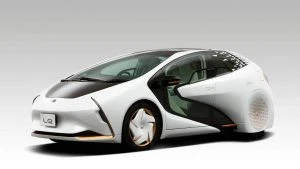
Toyota LQ Concept Solid-State
Toyota’s quick development of solid-state batteries for use in all their hybrid and electric vehicles by 2030 is a sign of the ramping up in EV production that is happening not only at Toyota but in all other big global automotive brands who are boosting investments in the anticipation of greater EV and hybrid vehicle consumerism.
What battery type does Tesla use? Currently, Tesla has been using heavy liquid lithium-ion battery technology. However solid-state batteries are really the next step in clever battery technology, especially for EVs. Why? Solid-state batteries offer much better energy density, which leads to smaller, lighter batteries for cars but with a vastly improved range before recharging is necessary. Solid-state batteries will also be able to recharge from empty (flat) to 80 % in just 15 min – not anywhere between 2 to 10 hours that is currently the norm, if you can find a spare fast charger to park up at.
The good news for solid-state batteries doesn’t stop here either, because solid-state batteries are inherently safer due to the lack of flammable liquid electrolytes that you’ll find in liquid lithium-ion batteries. You may have heard of various electronic devices bursting into flame? Well, liquid lithium-ion batteries bursting into flame and causing fires in various EVs over the last couple of decades has been an issue. This in itself has deterred many people away from buying into EVs altogether.
So, big dollars are being spent in the design of solid electrolyte batteries (solid-state batteries) that are stable, chemically inert, and still a good conductor of ions between the electrodes. In essence solid-state batteries will be doing away with the slopping, flammable liquid lithium-ion electrolyte battery designs.
By default, solid-state batteries are more stable, but they are also more compact in design, and therefore lighter. Solid state batteries thus pack more energy output into the same amount of storage space that heavier and lower-output liquid lithium-ion batteries require. Because solid-state batteries are lighter, they have more energy density, offer more range, and deliver a better power to weight ratio, and they also recharge faster.
Solid-state batteries have been used in small electronic devices like pacemakers (an amazing bit of life-changing tech) as well as radio frequency identification (RFID), and wearable devices for years. Having fewer bits and pieces involved in the solid-state battery design means fewer things are present to go wrong. In addition to their improved safety, size, and stability, solid-state batteries in EVs would also offer faster charging times, more travel range, and even greater energy density.
Solid electrolytes in solid-state batteries can even be composed from a number of everyday materials – even ceramics and glass. The challenge to making solid-state batteries viable, however, is developing the technology that is commonly used in small devices and applying it to large-scale applications like in an EV. Currently, solid state batteries are expensive to fabricate because they have been prone to cracking, which has been a result of the brittleness of the electrolytes inside the battery expanding and contracting during continual use. The new research and development is setting out to change this.
Toyota is cracking the problem and will be using their solid-state batteries in their new range of hybrid vehicles first, which is an ideal testing ground for their fully-kitted EVs soon. Volkswagen is also promising that they will have solid-state batteries in use and in their cars by 2024. Like Toyota and Volkswagen, BMW anticipates that solid-state batteries could make it into production cars by 2025. Tech giants Samsung and Panasonic are working away at creating a range of solid state batteries that automakers will be able to use. Toyota has partnered with Panasonic to pave the way to an EV future.
Hydrogen V8 ICE

Exciting news for internal combustion engine (ICE) lovers: Toyota, Mazda, Subaru and Kawasaki are wanting to collaborate on the attempt to keep the combustion engine alive while meeting all the global clean air targets. Not only that, but Toyota and long-time Japanese engineering partner Yamaha are at work developing a special new hydrogen-powered 5.0-litre V8 engine. Unlike a hydrogen fuel-cell car, which combines hydrogen and oxygen atoms to create electricity to drive a motor, this new hydrogen V8 internal combustion engine is a conventional piston-driven engine that has been tuned to burn hydrogen instead of petrol.
While this newly developed V8 engine isn’t completely new, the way it’s fuelled is. It’s a 5.0-litre naturally aspirated V8 that is based off the engine that has been used in the Lexus RC F coupe. Yamaha says that it produces around 335 kW of power at 6800 rpm and 540 Nm of torque at 3600 rpm. Having modified the injectors, the head, the intake manifolds and other engine components, this work has added up to make the engine environmentally friendly. The hydrogen-fed ICE has become less powerful than the petrol-fed V8 that the hydrogen engine is based on. In the Lexus RC F coupe, the petrol V8 puts out 472 kW and 536 Nm of torque, so while torque has increased a little, power has dropped considerably. That said, 331 kW is still a stonking amount of power to enjoy, and more often than not it is the torque that you really want in the real world conditions. You also still get the sound of a burbling V8, and what’s not to like about that!
Yamaha engineer, Takeshi Yamada, said that the engine has a different character to a conventional petrol motor. He stated that hydrogen engines provide a friendlier feel, making them easier to use even without having utilize other electronic aids for the drive.
Toyota is clearly committed to the project of providing ICE powerplants that use hydrogen as the fuel. Given that Toyota has run a hydrogen-powered Toyota Corolla in Japan’s Super Taikyu race series as well as showcasing a hydrogen-powered Toyota Yaris GR prototype with the same hydrogen engine technology, it is obvious that they want to continue with this new breed of ICE.
One of the beauties about burning hydrogen instead of petrol is that the hydrogen powerplant does not produce carbon dioxide, which is considered to be one of the primary contributors to global warming. There would also be no significant nitrogen oxides emissions from an ICE designed to burn hydrogen, thanks to the selective catalytic reduction technology used in the aftertreatment of the combustion gases.
“Hydrogen engines house the potential to be carbon-neutral while keeping our passion for the internal combustion engine alive at the same time,” Yamaha Motor president Yoshihiro Hidaka said. He also added that: “I started to see that engines using only hydrogen for fuel actually had very fun, easy-to-use performance characteristics”.
While hydrogen is plentiful in the universe, it must be separated from other compounds to be used as fuel. Up to the year 2020, most hydrogen was produced from fossil fuels, resulting in CO2 emissions. Hydrogen obtained from fossil fuels is often referred to as grey hydrogen, when emissions are released into the atmosphere. Blue hydrogen is the hydrogen produced from fossil fuels when emissions are captured through carbon capture and storage (CCS).
Hydrogen that is produced from fossil fuels using the newer non-polluting technology called methane pyrolysis is often called turquoise hydrogen.
You can also generate hydrogen from renewable energy sources, and this hydrogen is often referred to as green hydrogen. There are two practical ways of producing green hydrogen. One of the ways is to use electric power for producing hydrogen from the electrolysis of water. The other way of producing green hydrogen is to use landfill gas to produce the green hydrogen in a steam reformer. Hydrogen fuel, when it is produced by using renewable sources of energy like wind or solar power, is a renewable fuel.
Hydrogen can also be created from another renewable energy source called nuclear energy via electrolysis, and this is sometimes seen as a subset of green hydrogen, but it can also be referred to as being pink hydrogen.
Obviously, when a car can be designed to run on hydrogen that has been produced from renewable energy sources, then this is a good thing. Toyota and Yamaha remain adamant that this is great technology which could carve out a niche for itself in the new EV automotive landscape.
Toyota has also recently revealed a fleet of 12 zero tailpipe-emission concept vehicles, many of which will reach production in the coming years.
This is all good news stuff, especially for those of us who love the sound of an ICE instead of a silent EV. The noisy farts always get the best round of laughter!